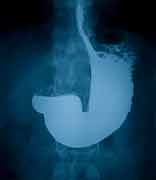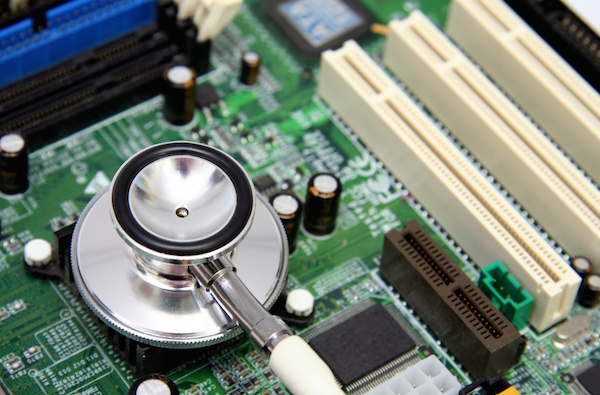
THURSDAY, April 7 (HealthDay News) — Silke Zeigler was fed up with “yo-yo” dieting in her struggle to maintain a healthy weight.
“The first realization was that diets didn’t work and actually made things worse, as after finishing the diet I put the weight I’d lost back on,” said Zeigler, 26, a taxi driver from the Wurzburg region of Germany. “So, I researched surgical options such as gastric bypass surgery or gastric banding. But, ironically, for these operations I wasn’t overweight enough.”
Then the university hospital in Wurzburg offered her a chance to participate in a trial of an innovative stomach “pacemaker,” aimed at curbing appetite and controlling weight.
Zeigler embraced the idea, in large measure because of the treatment’s reversibility. “That is, it can always be removed again without permanent effects on the anatomy of my stomach, such as [happens] in a gastric bypass surgery,” Zeigler noted.
Ten months after receiving the implantable device in what she called a “quite easy” operation, Zeigler said she’s lost about 80 pounds and kept it off. “I quickly noticed success because in the first few weeks I lost 20 kilos [44 pounds] and with every fading kilo my motivation increased,” she said.
The device, not yet approved for use in the United States, is dubbed “abiliti” by its California-based maker, IntraPace. According to the company, the device is implanted in the stomach during a one-hour laparoscopic procedure via small insertions in the abdominal wall.
Once in place, the device uses its food-detection sensor to sense whenever a patient eats or drinks. This prompts it to emit low energy electrical pulses to nerves that trigger a feeling of rapid fullness.
According to IntraPace, users can feel “a sensation” from the tiny impulses the device delivers. Zeigler said that, in her case, “the feeling of fullness occurs much sooner now than before.”
An activity sensor also tracks the patient’s food intake and physical exertion levels, sending that information automatically to a computer so patients and doctors can easily monitor (and adjust) eating and exercise habits.
“This is not to police the patients, but to help encourage positive results,” explained Chuck Brynelson, IntraPace’s chief executive officer.
To date, one completed trial, along with a second one still underway — both funded by IntraPace — have tested the device among a total of 65 patients. Both studies have been aimed at assessing the device’s safety and effectiveness, rather than comparing it to other weight-loss methods or medications.
The results of the first study were presented at the 2009 International Federation for the Surgery of Obesity and Metabolic Disorders meeting. In that trial, study author Thomas Horbach, of Schwabach, Germany, recruited obese individuals with an initial pre-implant body-mass index (BMI) of between 35 and 55 (30 being the statistical threshold for obesity).
After receiving the device, the participants lowered their daily food intake by an average of 45 percent, the researchers said, and they lost an average of 22 percent of their excess weight within a year of implantation.
IntraPace acknowledges that standard gastric bypass surgery currently produces even more dramatic results — typically a 50 percent to 60 percent loss of excess weight within a year. Another type of bariatric surgery, gastric banding, achieves between 34 percent and 38 percent weight loss during the first year post-surgery.
However, the company also points out that the more invasive bypass and banding surgeries come with more risks: 0.5 and 0.05 percent of such patients die, respectively; while 23 percent to 32 percent of bypass patients and 88 percent to 93 percent of gastric band recipients experience significant side effects. So far, the pacemaker surgery has prompted no deaths and no major side effects in those who have received it, IntraPace said.
But, some U.S. weight-loss experts remain less than enthused about the device.
Dr. Mitchell Roslin, chief of bariatric surgery at Northern Westchester Hospital in Mount Kisco, N.Y., said he takes a “very bearish view” of stomach pacemaker technology, dismissing it as having the effect of “a glorified placebo.”
“The kind of sophisticated communication that goes on between the stomach, the nerves and the brain is not as simple as turning on a light switch,” he said. “It’s not just about pulsing that nerve on, and hoping that that mimics the way the stomach signals the brain. But, the simple state of obesity pacemaker technology today is that all we can currently do is up the voltage or drop the voltage. And, in my opinion, that’s just not good enough.”
Another expert, registered dietician and assistant professor of clinical nutrition Lona Sandon, of the University of Texas Southwestern Dallas, said it remains to be seen if stomach pacemakers might have a significant role to play in weight loss.
“Certainly, it could be another tool in the box to help with the obesity problem,” she said. “Of course, the studies will have to play out and see what the risks are. But it seems that it is much less invasive and has the potential for less surgical risk compared with bariatric surgery, which is a pretty serious surgery that can entail lots of complications.”
There’s cost to consider, too: According to Brynelson, abiliti now costs between $20,000 and $23,000, which includes the device plus implantation in the stomach. That’s based on costs in Britain, where the device was recently approved for use.
Brynelson said that discussions between Intrapace and the U.S. Food and Drug Administration are underway, aimed at outlining the parameters of new trials that would have to be conducted before the device could be approved for American patients. In the most optimistic scenario, that would not happen before 2014, he said.
Sandon stressed that any weight-loss intervention should ideally include lifestyle changes. “With any of these devices that might help you eat less, you still need to pay attention to what you put in your mouth and make healthy food choices and increase physical activity to promote health overall,” she said. “Surgery does not replace good nutrition. Nor do any kind of implantable devices. Lifestyle habits are still key for overall health long-term.”
Abiliti recipient Zeigler said she couldn’t agree more with that advice.
“Of course, [my weight loss] is also due to a change of eating and living habits,” she said, noting that since the operation she coupled “a strong desire and will to lose weight” with an avoidance of fast foods and a diet tilted towards salads and whole grains.
More information
For more on standard weight loss surgery options, visit the U.S. National Institutes of Health.

